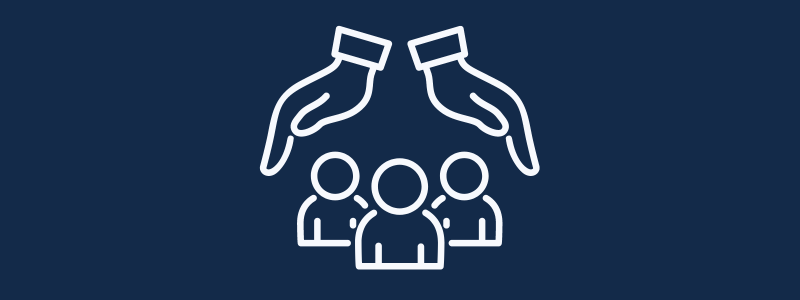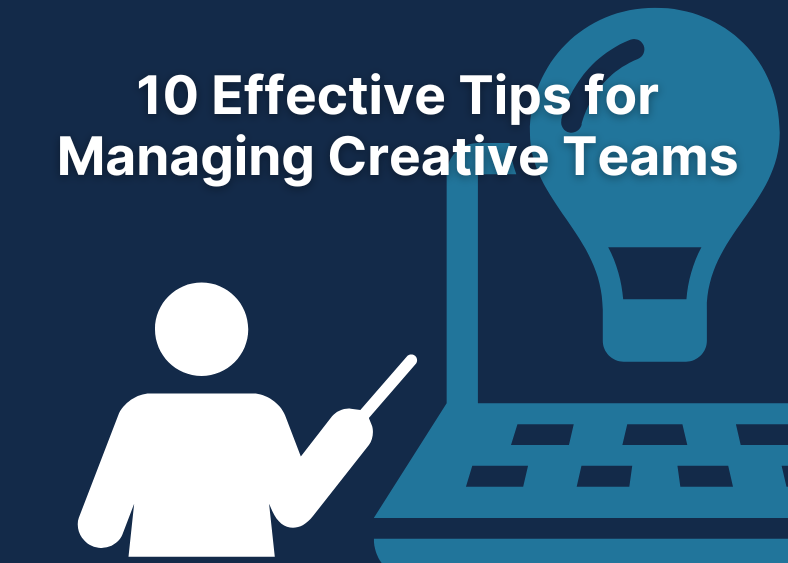Navigating the complexities of managing creative teams requires a nuanced approach that appreciates individuality while steering collective efforts toward shared goals. By encouraging calculated risks within defined parameters, managers can unlock unparalleled levels of innovation from their teams while meeting deliverable deadlines.
But managing creative teams isn’t just about keeping projects on track; it’s about fostering an environment where creativity thrives. Whether you’re leading graphic designers or marketing experts, the goal is to blend structure with flexibility.
My experience leading Brighter Vision, a company where creatives comprised most of the team, provides a unique perspective on managing this dynamic group. Having lived and breathed in a creative environment for years, I wasn’t just the CEO – I was entrenched in the day-to-day processes and challenges that creatives face. This firsthand understanding allows me to share insights beyond typical management theory, offering practical advice tailored to the specific needs of creative minds.
Furthermore, Brighter Vision’s success speaks volumes about our approach to fostering a thriving creative space. Our team consistently produced exceptional work, demonstrating the effectiveness of the methods I’ll outline in this article.
Outline
- Strategies to Effectively Manage Creative Teams
- The importance of empathy
- Providing clear direction and goals
- The Importance of Clear & Open Communication
- Crafting effective creative briefs for better output
- Hosting monthly employee owned meetings
- Maximizing Productivity & Efficiency
- Encourage risk taking
- Implementing effective project management tools and techniques
- Streamline the creative review and approval process
- Prioritizing tasks and managing workloads
- Remote Work in Maintaining Work-Life Balance and Well-being
- Promoting healthy work habits and boundaries
- Using an Agency Project Management Tool
Strategies to Effectively Manage Creative Teams
- The Importance of Empathy

Empathy is essential for any manager, but especially for managing teams full of creatives. Bad bosses deploy zero empathy, meaning an email you send will inevitably end up on the anti-work subreddit.
Creativity flourishes in an environment that cultivates trust, and empathy is a building block of trust. By putting yourself in your team’s shoes, you can foster a sense of trust and psychological safety that allows them to take risks and experiment freely. This translates to a willingness to share ideas without fear of judgment, leading to a richer pool of concepts and a higher chance of breakthroughs.
Empathy also allows you to recognize the emotional rollercoaster that often comes with the creative process. Creative minds can experience moments of self-doubt, frustration, anxiety, and even inspiration-induced exhaustion. An empathetic leader can identify these moments and provide the right kind of support, be it a pep talk, a shift in workload, or simply a listening ear. This demonstrates that you value their well-being and creates a more positive and sustainable creative atmosphere.
At my last company, Empathy was a critical component of our culture. So much so that we highlighted an employee in our all-hands meeting who displayed exceptional empathy once a week. The highlighted employee received a gift card to a local coffee shop and a special coffee mug for the week. It was a small gesture, but it demonstrated to the team the importance of empathy in our workplace, and thus, our managers led with empathy, too.
- Providing clear direction and goals

While creativity thrives on freedom, it also needs structure. Leading creative teams requires setting clear goals and expectations for each project so your team knows what they’re working towards. Break down complex tasks into manageable chunks and provide regular feedback to keep everyone on track.
Successful creative teams consistently deliver outstanding results when led effectively and work with purpose within a framework that encourages creativity without restricting it. However, providing that environment is challenging and requires balancing process rigor and allowing teams the time and space to do their best work.
But finding that perfect balance is tough! Too much structure can stifle creativity, but too little can lead to chaos. It’s all about finding that sweet spot. Establish guidelines and processes, but be open to adapting them when necessary. Trust your team to manage their time and tasks while providing support when needed.
The Importance of Clear & Open Communication
Clear communication is the backbone of any successful team, but it’s especially crucial when managing creative teams. Projects can quickly derail without open channels for feedback and ideas, and creative people can feel unheard and undervalued.
Here are a few strategies for opening paths to communication across your team.
- Crafting effective creative briefs for better output
A well-crafted creative brief is like a roadmap for your team. It should clearly outline the project goals, target audience, key messaging, and deliverables. When done successfully, it will encourage collaboration and help guide the creative process, ensuring the team is working towards a shared vision.
- Hosting Monthly Employee Owned Meetings

Employee churn was a problem at my last company. While we had a core group of rockstars, additional employees either did OK or we had to part ways with them quickly.
After nearly a year of struggling, we changed our management approach: we implemented regular check-ins, but they were not performance reviews. Instead, they were employee-owned monthly meetings, and our employee retention did a complete 180.
These meetings were employee-owned meetings, and the employees drove the agenda. Sometimes, these discussions were about video games. Other times, they were about working through challenging client problems. Occasionally, they were about career development and opportunities.
The key is that this was not a manager-driven meeting. The agenda was fully owned by the employees. We practiced what we preached from an empathy perspective. We didn’t just say we cared about our employees; we literally dedicated time every month to discussing what they cared about.
Maximizing Productivity and Efficiency in Creative Workflows
Creative work can be messy and unpredictable, but that doesn’t mean it has to be inefficient. With the right tools and processes, you can streamline your workflows and maximize productivity.
- Encourage Risk Taking
Effectively managing creative teams hinges on the delicate balance between fostering an environment where risk-taking is encouraged and setting clear, constructive boundaries. Creative minds thrive in spaces where their ideas can flow freely, yet without a framework to guide this creativity, projects can veer off course. Here are several strategies for striking that perfect balance.
- Create a Safe Space for Creativity: Creative problem-solving is taxing, so the foundation of encouraging risk-taking is creating an atmosphere where team members feel safe to express their ideas, no matter how unconventional. This means not only providing positive reinforcement but also ensuring that failures are seen as part of the learning process rather than setbacks.
- Set Clear Objectives and Boundaries: While allowing creative freedom is important, defining clear project objectives and constraints is crucial. These guidelines help channel creativity towards productive outcomes that align with your client’s goals or project requirements.
- Promote Open Communication: Encourage your team to openly share their thoughts and feedback by promoting regular brainstorming sessions and one-on-one check-ins. This open line of communication ensures that everyone feels heard and contributes to the project’s collective success.
- Reward Lateral Thinking: Recognizing and rewarding innovation within your team is critical to letting creativity flourish. Whether through formal recognition programs or casual shout-outs during meetings, acknowledging creative solutions reinforces the value placed on thinking outside the box.
- Maintain Flexibility in Processes: While structure is necessary for any successful project management strategy, allowing flexibility within those frameworks enables creatives to explore different avenues without feeling constrained by rigid procedures.
- Leverage Technology Tools: Incorporating tools like Motion.io into your workflow can streamline administrative tasks, leaving more room for creativity in your team.
- Implementing effective project management tools and techniques
Project management software can be a game-changer for creative teams. It allows you to assign tasks, set deadlines, and track progress all in one place. But don’t just rely on technology – establish clear processes and workflows that everyone can follow.
Utilizing client onboarding and project management tools like Motion.io can help creative team managers ensure smooth operations and keep everyone at the top of their game. This tool, built for creatives and their clients, offers flexibility and features specifically designed for managing creative projects, from design work to marketing and advertising materials. It also allows your team to stay focused on the work that matters instead of client management (which is not what a creative likes to do).
- Streamline the creative review and approval process
The review and approval process can be a significant bottleneck for creative projects. Establish clear guidelines for feedback and approvals, and use collaborative tools to streamline the process. Set realistic deadlines and hold everyone accountable for meeting them.
Implementing efficient review and approval processes is crucial for maximizing productivity in creative workflows. Establishing clear guidelines for feedback, setting realistic deadlines, and using collaborative tools can streamline these processes. Minimizing unnecessary rounds of revisions and ensuring timely approvals not only helps keep projects moving forward but also improves employee morale. Nothing destroys enthusiasm quite like a pixel-pushing client.
Use a design feedback tool, like Motion.io! Our design feedback tool helps with the creative review & client approval process so that your team can spend more time creating and less time following up.
- Prioritizing tasks and managing workloads

Creative teams often have multiple projects going on at once, which can lead to overwhelm and burnout. Help your team prioritize tasks based on urgency and importance and ensure workloads are balanced across the team. Encourage breaks and time off to recharge and avoid burnout.
Effective creative team management involves prioritizing tasks and managing workloads to ensure optimal productivity. Assessing project urgency, complexity, and resource availability helps determine priorities. Balancing workloads across team members, considering individual strengths and capacities, is important for preventing burnout and maintaining high-quality output.
Remote Work in Maintaining Work-Life Balance and Well-being
Creative work can be mentally and emotionally demanding, and it’s easy for team members to burn out if they don’t have a healthy work-life balance. As a leader, it’s your responsibility to promote well-being and prevent burnout in your team.
We found that a healthy balance of remote work helped our team morale, improved employee performance, and reduced employee churn. Most organizations offer at least some remote work options in a post-COVID world. But in case you’re on the fence, here are examples of how remote work can improve the well-being of creative teams, with some scientific data to support the claims:
- Promoting healthy work habits and boundaries

Encourage your team to set healthy boundaries around their work hours and workload. Model good habits, and avoid sending emails or messages outside regular working hours. Encourage breaks and time off, and make sure your team members take advantage of their vacation time.
Maintaining work-life balance is essential for the well-being and productivity of creative teams. Promoting healthy work habits, such as reasonable working hours, regular breaks, and proper time management, helps prevent burnout and ensures team members can perform at their best.
Reduced Stress and Improved Work-Life Balance: Remote work offers creatives more control over their schedules, allowing them to work during peak productivity hours. This flexibility reduces feelings of pressure and time urgency, leading to lower stress levels. A Stanford study published in 2013 found that employees with more schedule control reported significantly lower stress and improved overall well-being. Additionally, remote work eliminates the daily commute, freeing up valuable time for personal activities and fostering a better work-life balance, which is crucial for creative rejuvenation.
Enhanced Autonomy and Boosted Morale: Creative professions often thrive on a sense of autonomy. Remote work empowers creatives to design their workspaces for optimal comfort and inspiration. This autonomy fosters a sense of ownership over their work, leading to increased motivation and job satisfaction. Research found a strong correlation between employee autonomy and job satisfaction, with satisfied employees reporting higher morale and lower burnout rates.Improved Focus and Increased Creativity: The constant distractions of a traditional office environment can hinder creative flow. Remote work allows creatives to find quiet, distraction-free zones to focus on their tasks. Additionally, a change of scenery can spark inspiration. Studies by the National Taiwan University in 2022 suggest that spending time in nature can enhance cognitive function and creative thinking. With remote work, creatives can take breaks to walk in nature or design their workspace to incorporate natural elements, fostering a more inspiring and productive environment (and you, as a manager, should encourage those mental breaks!).
📢 Key Takeaway: Managing creative teams involves balancing collaboration, clear direction, and flexibility. Encourage open communication for idea flow. Set clear goals but allow freedom to explore. Recognize achievements to keep the team motivated.
Using an Agency Project Management Tool
Now that you understand how to maximize the value your creative team brings through better management & daily communication, it’s critical to get the right client portal and project management tool so you can remain focused on business strategy & developing your team’s skills.
An agency project management tool like Motion.io can help you better focus on leading your team, increase their creative output, and empower your creatives to stay out of email threads and be more focused on delivering high-value work.
Try Motion.io
Learn the platform in less than an hour. Start elevating your client experience in less than a day.

